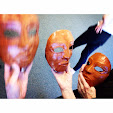Sunday, August 24, 2014
Boyhood
Directed by Richard Linklater
Produced by Sandra Adair, Caroline Kaplan, Richard Linklater, Kirsten McMurray, Vincent Palmo Jr., Jonathan Sehring, John Sloss, Cathleen Sutherland, Anne Walker-McBay.
Color, live action, 164 minutes
Teens and up (see below)
I haven't posted here in a long time because living demands more attention than spectating, but I'm taking time out to plug a movie about, well, living: BOYHOOD. If you've read about it at all, you know that indie director Richard Linklater, whose films often deal with persistence and change through time, cast the lead, Ellar Coltrane, at the age of six. Everyone involved aged 12 years during the making of the movie.
Aside from that layer adding to what is already a moving chronicle of a family over the last decade, the shooting circumstances and lives of the makers that shadow the film add a level of richness to BOYHOOD that is less palpable, though obviously always present, in other films. Knowing the level of commitment of the ensemble of actors and crew, imagining their collaboration and the many ways the film likely parallels developments in their own lives, and sensing the sadness they must have felt when the shooting stopped, adds to the pondering of love and loss that runs through BOYHOOD. This is most explicit in a scene during which Patricia Arquette, who plays the central character's mother, lectures a psychology class on John Bowlby's attachment theory.
During a Q+A by producer John Sloss he mentioned that his kids—who are currently the sames ages as the characters Mason and Sam are at the start of BOYHOOD—have only seen that first section. So one way to watch this with kids would be segment by segment as they age. It's a movie to savor and revisit. For those watching it with teens now, while it's still fresh, it's quickly becoming a rite of passage.
Tuesday, December 13, 2011
Bullfrog Films for Activists
Here is a press release from Bullfrog Films about a great project; check it out:
Bullfrog Films Launches Groundbreaking Community Screenings Site
December 2011
Bullfrog Films, the nation’s leading distributor of films about environmental and related social justice issues, is excited to announce a groundbreaking initiative that brings documentary film to the heart of local and national activism.
Bullfrog Communities (http://www.bullfrogcommunities.com) empowers local organizers and activists by providing screening tools, an online publicity platform and licenses to organize free or for-profit screenings of award-winning new documentaries. Bullfrog Communities also enables organizers and viewers to participate in online campaigns relating to the documentary to further enact change.
"Film is uniquely capable of bringing an audience simultaneously up to speed on any given issue, and organizers can take advantage of that moment to open up an informed discussion of critical social issues in their community and, importantly, to take concerted action," said John Hoskyns-Abrahall, president of Bullfrog Films, founder of Bullfrog Communities.
One of the unusual features of Bullfrog Communities is that the screening license allows organizers to charge admission and to keep the proceeds from the screenings. So, in addition to the shared educational experience that only film can provide, a community screening can be an inexpensive, ready-made and attractive fundraiser for local groups.
Each film’s website provides a screening and discussion guide that details how to put on a successful screening; a list of suggested questions for the Q&A following the film; and a handout with links to resources and suggestions for further action.
The website features an expanding group of online communities built around different issues such as food, water, energy & climate change, civil liberties, and economic justice. Each issue area features a growing number of films plus a news feed and an ongoing discussion of the issue and of screenings nationwide. In this way the lessons learned from successful screenings in one community can be transferred to another.
Go to http://www.bullfrogcommunities.com to sign up and start the discussion going on the most pressing issue in your community! JOIN Bullfrog Communities to be alerted when new films are released for community screenings.
Bullfrog Films Launches Groundbreaking Community Screenings Site
December 2011
Bullfrog Films, the nation’s leading distributor of films about environmental and related social justice issues, is excited to announce a groundbreaking initiative that brings documentary film to the heart of local and national activism.
Bullfrog Communities (http://www.bullfrogcommunities.com) empowers local organizers and activists by providing screening tools, an online publicity platform and licenses to organize free or for-profit screenings of award-winning new documentaries. Bullfrog Communities also enables organizers and viewers to participate in online campaigns relating to the documentary to further enact change.
"Film is uniquely capable of bringing an audience simultaneously up to speed on any given issue, and organizers can take advantage of that moment to open up an informed discussion of critical social issues in their community and, importantly, to take concerted action," said John Hoskyns-Abrahall, president of Bullfrog Films, founder of Bullfrog Communities.
One of the unusual features of Bullfrog Communities is that the screening license allows organizers to charge admission and to keep the proceeds from the screenings. So, in addition to the shared educational experience that only film can provide, a community screening can be an inexpensive, ready-made and attractive fundraiser for local groups.
Each film’s website provides a screening and discussion guide that details how to put on a successful screening; a list of suggested questions for the Q&A following the film; and a handout with links to resources and suggestions for further action.
The website features an expanding group of online communities built around different issues such as food, water, energy & climate change, civil liberties, and economic justice. Each issue area features a growing number of films plus a news feed and an ongoing discussion of the issue and of screenings nationwide. In this way the lessons learned from successful screenings in one community can be transferred to another.
Go to http://www.bullfrogcommunities.com to sign up and start the discussion going on the most pressing issue in your community! JOIN Bullfrog Communities to be alerted when new films are released for community screenings.
Wednesday, October 27, 2010
The 8½ Foundation
Tonight, while Googling Tilda Swinton, I discovered that in 2005—coincidentally the year I began Alternative Films for Kids—she co-founded The 8½ Foundation, a nonprofit whose "aim is to create a new birthday: a film birthday, at the age of 8½, that celebrates the power of cinema to expand children’s horizons and welcomes children into the wider world of movies, beyond what is normally available to them at the multiplex or on their TV screens."
They have a wonderful list of recommended films, many of which are here, many more of which are not (I'm slow, and busy, and don't spend as much time expanding this list as I'd like). Check it out.
They have a wonderful list of recommended films, many of which are here, many more of which are not (I'm slow, and busy, and don't spend as much time expanding this list as I'd like). Check it out.
Thursday, July 16, 2009
Stop Lookin', Listen
This blog focuses on visual media for children that I, in my infinite personal bias, would say falls outside the mainstream. Truth is, my kids spend more time listening to audio books (and reading), than watching, and I think that's a good thing. Limiting sensory input to one channel often deepens the waters.
 This brings me to a plug for the short-story podcasts of The New Yorker. I've been listening to them during downtime lately, and this week I had to pull my kids into my bedroom to have a listen to Jonathan Franzen reading "Coyote v. Acme" by Ian Frazier. Frazier's parody of a legal brief, contrasting the formal, deflective language of legalese and the slapstick antics of the famous Warner Bros. cartoons is deft, hilarious, and affectionate. My children greatly enjoyed it.
This brings me to a plug for the short-story podcasts of The New Yorker. I've been listening to them during downtime lately, and this week I had to pull my kids into my bedroom to have a listen to Jonathan Franzen reading "Coyote v. Acme" by Ian Frazier. Frazier's parody of a legal brief, contrasting the formal, deflective language of legalese and the slapstick antics of the famous Warner Bros. cartoons is deft, hilarious, and affectionate. My children greatly enjoyed it.
Another good one for children (8+up, I'd say) is George Saunders reading "You Must Know Everything," by Isaac Babel. There's plenty to explore in the free podcast area of iTunes, from Selected Shorts and This American Life to more independent efforts—a free library for a rainy day or long car trip.
 This brings me to a plug for the short-story podcasts of The New Yorker. I've been listening to them during downtime lately, and this week I had to pull my kids into my bedroom to have a listen to Jonathan Franzen reading "Coyote v. Acme" by Ian Frazier. Frazier's parody of a legal brief, contrasting the formal, deflective language of legalese and the slapstick antics of the famous Warner Bros. cartoons is deft, hilarious, and affectionate. My children greatly enjoyed it.
This brings me to a plug for the short-story podcasts of The New Yorker. I've been listening to them during downtime lately, and this week I had to pull my kids into my bedroom to have a listen to Jonathan Franzen reading "Coyote v. Acme" by Ian Frazier. Frazier's parody of a legal brief, contrasting the formal, deflective language of legalese and the slapstick antics of the famous Warner Bros. cartoons is deft, hilarious, and affectionate. My children greatly enjoyed it. Another good one for children (8+up, I'd say) is George Saunders reading "You Must Know Everything," by Isaac Babel. There's plenty to explore in the free podcast area of iTunes, from Selected Shorts and This American Life to more independent efforts—a free library for a rainy day or long car trip.
Labels:
all ages,
audio,
shorts,
view online
Tuesday, June 16, 2009
What's On Your Plate?
 Directed by Catherine Gund
Directed by Catherine GundProduced by Tanya Selvaratnam
Co-produced by Sadie Rain Hope-Gund and Safiyah Kai Russell Riddle
With animation by Hubbub Inc.: Emily Hubley and Jeremiah Dickey
Color, documentary, 73 minutes
All ages
Upcoming screening:
BAM Cinemafest/Afro-Punk Opening Night Outdoor Screening
Saturday, June 27th, 6:00 pm
I show my kids a lot of documentaries—more than they want to see, frankly. So when I pulled What's On Your Plate? out of the envelope and said, "It's about food!" my son put on his blah face. "I've seen a ton of that stuff. I know." He's used to home cooking, CSAs, the backyard garden (even if a groundhog has kept it from coming up this year), he knows everything there is to know about healthy eating. But when the rest of the family popped it in and started watching, he came in and got hooked.
Co-produced and 'hosted' by two 7th-grade girls, Sadie and Safiyah, who live and eat in New York City, What's On Your Plate? welcomes a kids-eye view of food politics. School lunches, family farming, the mystery treat "Funyuns," and diet-related diseases are some of the topics, but the 'girl guides' leading the exploration, Sadie and Safiyah, bring humor and energy that keep the material from being dry or didactic, and so do their lively interview subjects—chefs, food activists, and farmers. Director Gund has no wish to feed us a lot of talking heads—she'd rather follow the girls as they amble through the city, visit the Angels, a Mexican farming family, or select cucumbers at their CSA. You get to watch people eat a lot. And Sadie and Safiyah don't shrink from asking the heads of food for NYC schools why Snapple is considered a suitable beverage to be serving kids from machines. "They don't have to drink it," one says.
I think one reason my kids found What's On Your Plate? interesting is that it talks about what happens when the food we see being grown around us—in Ulster County, two hours north of the city—reaches New York City. How do city residents get to know farmers? How does farm-fresh food get distributed to schools? How do people go about changing what's on their plate?
Labels:
activism,
all ages,
documentary,
eco,
girl power
Saturday, May 23, 2009
The Curious Adventures of Mr. Wonderbird

Available (and preferable) in French as Le Roi et l'Oiseau
Directed by Paul Grimault
Produced by André Sarrut
Color, animation, 63 minutes
Based on "The Sheperdess and the Chimney Sweep," by Hans Christian Andersen, adapted by Grimault and Jacques Prévert
Recommended for 8 and up
Astonishing for its inventiveness and surrealism, this odd and striking story may not be embraced by every child but is sure to give moments of delight. It goes by several titles and is available in both French and English; in this version, the title character, a despot-defying bird (who happens to be a doting single dad), is voiced hilariously by Peter Ustinov. A tyrant king, living in a castle high above his subjects, is in love with the portrait of a shepherdess, who comes to life from a painting. She and her true love, a chimney sweep, escape into a deserted city (picture Venice painted by de Chirico), and are then trapped in an underground kingdom where the king's subjects live without birds or sunlight. Full of surprises, amusements, and stunning animation. Apparently some have picked this gem up for a buck at WalMart, but greatly preferable: order the director's version, LE ROI ET L'OISEAU from Amazon.fr. The story easily survives a lack of subtitling, and kids deserve to see this level of cinematic art in the version intended by the creators. A few caveats: the king, who is both an object of fun and creepy, shoots bird for sport (though we don't see him kill one) and destroys his city with a giant waldo; there are moments of peril for major characters and the king dispenses with minor ones by pushing a button so they disappear through the floor or by having them flung aside by his robotic henchman. This is available in the English version on VHS from Facets for mail rental.
Thursday, May 21, 2009
Star Trek
The buzz was up about STAR TREK 2009. Good for kids, good story, very moving. My kids are now 12 and nearly 10, and maybe because they're a bit older now, tweens in fact, I talked them into going. My husband read me the review from Kids-in-Mind, but no red flags. Violence and gore got a 6 rating from them—compare to the 7 rating given PIRATES OF THE CARIBBEAN, which my kids saw over a year ago.
Besides, a younger friend of theirs had gone, and people were saying it's fine for kids.
Whoa, was I mistaken. Neither one of them liked the violence, the volume, the velocity—the three off-putting Vs of PG13dom. I don't know how Kids-in-Mind decided to rate the violence at 6. How could a man bound to a table to be tortured, a large insect forced down his throat, rate a 6? What kind of torture gets a 10? It feels like the world is getting less sensitive, but I'm becoming more grateful for my children's sensitivity.
My son is a particular fan of the MPAA ratings system—he even has it tacked to his bedroom wall. Because of him I've adjusted my attitude toward ratings. When I was single and living in New York, I once interviewed the director Abel Ferrara and recall his outrage that his teenage son might be prohibited from seeing whatever movie he liked. From his point-of-view it was a self-expression issue, and I agreed.
For my son, it's a self-protection issue. He values the ratings system because he's not ready for sexual themes, he doesn't like seeing cruelty, especially if it's aimed at animals, and Hollywood movies tend to overwhelm him with their explosions, constant orchestral climaxing, and endless chase sequences. He's the one sitting through the previews with his fingers in his ears.
Another reason my kids didn't go in for STAR TREK is that they lack the allegiance, formed over decades, to the series that my husband and I have. While we are not Trekkers, I for one spent a good deal of my youth with the crew of the Enterprise. Naturally I paid close attention to the women, the few there were: Nurse Christine Chapel, Yeoman Janice Rand, and the biggie: Lt. Uhura.
 Uhura and the actor who played her, Nichelle Nichols, carry a lot of cultural heft. Nichols was one of the first Black women on a TV series not to play a domestic worker (Diahann Carol in the 1968 Julia was another trailblazer I watched without quite understanding, but maybe intuiting, the import—I was seven that year). An episode in which she kissed William Shatner broke a barrier. After the first season, she thought of quitting, but Martin Luther King, Jr. persuaded her to stay on, citing the impact she was having.
Uhura and the actor who played her, Nichelle Nichols, carry a lot of cultural heft. Nichols was one of the first Black women on a TV series not to play a domestic worker (Diahann Carol in the 1968 Julia was another trailblazer I watched without quite understanding, but maybe intuiting, the import—I was seven that year). An episode in which she kissed William Shatner broke a barrier. After the first season, she thought of quitting, but Martin Luther King, Jr. persuaded her to stay on, citing the impact she was having.
Her character never rose to the prominence many viewers would have liked, and struggled in relative obscurity even when STAR TREK crossed into feature film territory.
But it still shocked me, though maybe it shouldn't have, to see how little the capable Zoe Saldana has to work with in the new STAR TREK. While her brethren are given emotionally rich origin stories to add depth to their relationships, she is left with a gag about her first name and a running sex joke about her professional field of linguistics. It's implied that she wants to serve on the Enterprise in order to be near her boyfriend, Spock. Gone is the dignity of the TV version of Uhura, who once came upon a shipmate and began speaking Swahili with him (too bad he turned out to be a monster in disguise). I will never forget sitting in my suburban living room listening to Swahili and thinking it the most beautiful language I'd ever heard.
emotionally rich origin stories to add depth to their relationships, she is left with a gag about her first name and a running sex joke about her professional field of linguistics. It's implied that she wants to serve on the Enterprise in order to be near her boyfriend, Spock. Gone is the dignity of the TV version of Uhura, who once came upon a shipmate and began speaking Swahili with him (too bad he turned out to be a monster in disguise). I will never forget sitting in my suburban living room listening to Swahili and thinking it the most beautiful language I'd ever heard.
Besides, a younger friend of theirs had gone, and people were saying it's fine for kids.
Whoa, was I mistaken. Neither one of them liked the violence, the volume, the velocity—the three off-putting Vs of PG13dom. I don't know how Kids-in-Mind decided to rate the violence at 6. How could a man bound to a table to be tortured, a large insect forced down his throat, rate a 6? What kind of torture gets a 10? It feels like the world is getting less sensitive, but I'm becoming more grateful for my children's sensitivity.
My son is a particular fan of the MPAA ratings system—he even has it tacked to his bedroom wall. Because of him I've adjusted my attitude toward ratings. When I was single and living in New York, I once interviewed the director Abel Ferrara and recall his outrage that his teenage son might be prohibited from seeing whatever movie he liked. From his point-of-view it was a self-expression issue, and I agreed.
For my son, it's a self-protection issue. He values the ratings system because he's not ready for sexual themes, he doesn't like seeing cruelty, especially if it's aimed at animals, and Hollywood movies tend to overwhelm him with their explosions, constant orchestral climaxing, and endless chase sequences. He's the one sitting through the previews with his fingers in his ears.
Another reason my kids didn't go in for STAR TREK is that they lack the allegiance, formed over decades, to the series that my husband and I have. While we are not Trekkers, I for one spent a good deal of my youth with the crew of the Enterprise. Naturally I paid close attention to the women, the few there were: Nurse Christine Chapel, Yeoman Janice Rand, and the biggie: Lt. Uhura.
 Uhura and the actor who played her, Nichelle Nichols, carry a lot of cultural heft. Nichols was one of the first Black women on a TV series not to play a domestic worker (Diahann Carol in the 1968 Julia was another trailblazer I watched without quite understanding, but maybe intuiting, the import—I was seven that year). An episode in which she kissed William Shatner broke a barrier. After the first season, she thought of quitting, but Martin Luther King, Jr. persuaded her to stay on, citing the impact she was having.
Uhura and the actor who played her, Nichelle Nichols, carry a lot of cultural heft. Nichols was one of the first Black women on a TV series not to play a domestic worker (Diahann Carol in the 1968 Julia was another trailblazer I watched without quite understanding, but maybe intuiting, the import—I was seven that year). An episode in which she kissed William Shatner broke a barrier. After the first season, she thought of quitting, but Martin Luther King, Jr. persuaded her to stay on, citing the impact she was having.Her character never rose to the prominence many viewers would have liked, and struggled in relative obscurity even when STAR TREK crossed into feature film territory.
But it still shocked me, though maybe it shouldn't have, to see how little the capable Zoe Saldana has to work with in the new STAR TREK. While her brethren are given
 emotionally rich origin stories to add depth to their relationships, she is left with a gag about her first name and a running sex joke about her professional field of linguistics. It's implied that she wants to serve on the Enterprise in order to be near her boyfriend, Spock. Gone is the dignity of the TV version of Uhura, who once came upon a shipmate and began speaking Swahili with him (too bad he turned out to be a monster in disguise). I will never forget sitting in my suburban living room listening to Swahili and thinking it the most beautiful language I'd ever heard.
emotionally rich origin stories to add depth to their relationships, she is left with a gag about her first name and a running sex joke about her professional field of linguistics. It's implied that she wants to serve on the Enterprise in order to be near her boyfriend, Spock. Gone is the dignity of the TV version of Uhura, who once came upon a shipmate and began speaking Swahili with him (too bad he turned out to be a monster in disguise). I will never forget sitting in my suburban living room listening to Swahili and thinking it the most beautiful language I'd ever heard.
Labels:
African-American history,
feature,
girl power,
hollywood
Friday, April 10, 2009
FLOW: For Love of Water
 2008, color documentary, 93 minutes
2008, color documentary, 93 minutesDirected by Irena Salina
Produced by Steven Starr
8 and up
Salina's documentary views the global water crisis through the eyes of activists struggling for access to clean, free water. The stories told here are fairly easy to follow for 8 and up, and kids used to seeing plastic bottles of 'blue gold' for sale everywhere really ought to hear this side of things. Activist/thinkers Vandana Shiva and Maude Barlow figure prominently in this narrative of an essential question of our time: can nature—the very elements of life—be owned? Or are they aspects of the worldwide commons, our birthright, what we share and steward together?
In the Hudson Valley, this film is making the rounds as a fundraiser for water-related issues such as those raised in Rosendale,NY by Save the Lakes.
Labels:
activism,
documentary,
eco,
girl power,
poverty,
science
Thursday, January 15, 2009
Preview + Review of Long-Awaited CORALINE
CORALINE is scheduled for release to theaters on February 6, 2009.
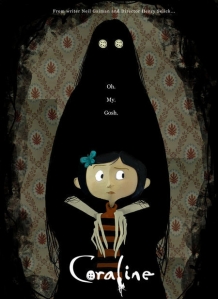 My son Ray has been making movies since he was six: stop motion animation, live action, and lately, CGI parodies of Star Wars. He reads film production books and bios of animators like Chuck Jones, and loves ‘making-of’ bonus features and little biopics about revered figures like Ray Harryhausen. One of his ‘mentors’ is Henry Selick, who has just completed his adaptation (for 3D stop-motion animation) of Neil Gaiman’s novel, Coraline.
My son Ray has been making movies since he was six: stop motion animation, live action, and lately, CGI parodies of Star Wars. He reads film production books and bios of animators like Chuck Jones, and loves ‘making-of’ bonus features and little biopics about revered figures like Ray Harryhausen. One of his ‘mentors’ is Henry Selick, who has just completed his adaptation (for 3D stop-motion animation) of Neil Gaiman’s novel, Coraline.
It was our enormous good fortune—mine, my son’s, my daughter’s, my husband’s, and his mother’s—to visit the set of Coraline a couple of years ago, and a real treat to see a preview screening of the finished work the other night in Manhattan, with Henry Selick on hand to answer audience questions.
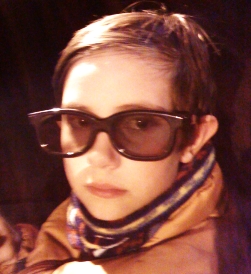 Ray, who is 11, wasn’t sure he wanted to see what he called a ‘horror’ movie. His 9-year-old sister, who acts in most of his movies and in her own monologue-driven shorts, was firm: she wouldn’t go to the screening. The monstrous Other Mother of the previews, and the prospect of having her lunge from the screen, were horrors they could live without.
Ray, who is 11, wasn’t sure he wanted to see what he called a ‘horror’ movie. His 9-year-old sister, who acts in most of his movies and in her own monologue-driven shorts, was firm: she wouldn’t go to the screening. The monstrous Other Mother of the previews, and the prospect of having her lunge from the screen, were horrors they could live without.
So, Ray and I headed into NYC with the plan that he would shut his eyes, pull his jacket up over his face, and hold his hands to his ears if it all got to be too much. He was willing to endure, if only for the Q&A portion of the evening.
As it turns out, he didn’t have to worry too much. He only shut his eyes once, and not for long. While the idea of Coraline is truly terrifying—a girl is left alone to rescue her supernaturally abducted parents—its creators have allowed the idea to carry most of the weight of emotion, as with the best fairy tales, and haven’t piled onto it with 3D shock effects or long, anxiety-provoking suspense sequences. The Nightmare Before Christmas, with its cast of characters in varying states of decomposition, is more horrific—at least to me, and I think my son, who got to an age where he felt too uneasy to watch it, and wouldn’t go near the undead-dominated Corpse Bride, would agree.
Henry Selick has done a beautiful job of reconceptualizing the novel for the screen and for stop motion. From the first moments, when metal hands sew up a doll-sized version of the title character and cast her into a void, it feels like this is a movie partly about the animator and the animator’s art. These are the hands of the evil Other Mother, creator and destroyer of the Other World, but here they are, bare of fleshly trappings, primordial armature. We come to find that the energy of children is what makes the Other Mother’s material other world, and it is their life force that makes it beautiful, whimsical, and inviting.
If you have watched any of the featurettes about Coraline, you have seen artist after artist toiling and tinkering away, as artists always do on these projects, though now, with the Internet, in less obscurity. They can even blog about their work for Laika Studios. It’s hard to watch that image of armature hands making the Coraline doll and not think of all the human hands that have gone into the making of this supremely hand-made movie, and seeing in these moments a tribute to them all (certainly they deserve a tribute, including those several dozen Laika workers, I was sorry to read, who were recently laid off).
OtherMotherWorld is especially fanciful and so packed with detail it's hard to imagine not seeing the movie many times to try to take it all in. Henry S. has ensured that the Other Mother’s overture to Coraline is suitably seductive. She—and we—are truly tempted to stay and sample more delights from the animators’ cabinet of wonders. (And the wonders really are wonderful; we laughed throughout the early other world scenes.)
Henry Selick’s Other Mother is a kind of ‘50s fantasy mom—she cooks brilliantly in heels, perfect make-up, and manicure and wears a stainless, starched apron. Other Father is affable, doting, and fun (aside from the saucy, riotous French and Saunders as the Misses Spink and Forcible, my favorite vocal performance is John Hodgman's as the Fathers Real and Other).
Coraline's real world parents, by contrast, are familiar to us as contemporary, overworked telecommuters (fortunate in that sense, they write at home on gardening) who share the work of their life equally, don’t exactly excel in the kitchen, and don’t have much time for their daughter.
That Coraline's creativity will rival the Other Mother's is intimated by a lovely scene that is not in Neil Gaiman’s book. Having returned from an early foray into the other world, Coraline finds her apartment empty; her parents have not come home from work and grocery shopping. Newly arrived in a strange place, friendless and now abandoned by her parents, she goes to bed alone, making pillow-people versions of her mom and dad to comfort herself—the Other Mother isn't the only one who can conjure power from a doll. I think Coraline's realization that they're not coming back is the scariest moment in the story (though Gaiman's protagonist is pretty brave at this point, as I recall). Henry S. wisely lingers long enough for us to feel her loneliness and her sadness.
A resourceful adventurer who is, like too few movie protagonists—even at the dawn of the 21st century—a girl, Coraline would be perfect if not for Henry S.’s addition of a boy to come to her aid in her time of need. Or so I thought when I heard about him. But Wybie (nicknamed "Why Be Born" by Coraline—I guess Henry S. knew some of us would resist), who gives Coraline someone other than a (really cool) cat to dialog with, adds a melancholy element to the other world, where he is more expressive for his muteness.
When my son and I came back up the Hudson River the day after the screening, and made our report to his sister, she said, “I think I’ve changed my mind. I do want to see Coraline.” I look forward to seeing it again with her.
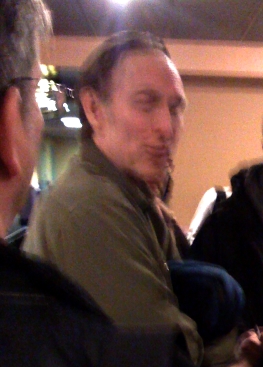 We were too shy to ask for a shot of Henry S. with Ray, but here he is after the Q&A. Be sure to view through your 3D glasses.
We were too shy to ask for a shot of Henry S. with Ray, but here he is after the Q&A. Be sure to view through your 3D glasses.
I'll be blogging more thought on Coraline on my other blog, Oswegatchie. Look for the Coraline tag.
 My son Ray has been making movies since he was six: stop motion animation, live action, and lately, CGI parodies of Star Wars. He reads film production books and bios of animators like Chuck Jones, and loves ‘making-of’ bonus features and little biopics about revered figures like Ray Harryhausen. One of his ‘mentors’ is Henry Selick, who has just completed his adaptation (for 3D stop-motion animation) of Neil Gaiman’s novel, Coraline.
My son Ray has been making movies since he was six: stop motion animation, live action, and lately, CGI parodies of Star Wars. He reads film production books and bios of animators like Chuck Jones, and loves ‘making-of’ bonus features and little biopics about revered figures like Ray Harryhausen. One of his ‘mentors’ is Henry Selick, who has just completed his adaptation (for 3D stop-motion animation) of Neil Gaiman’s novel, Coraline. It was our enormous good fortune—mine, my son’s, my daughter’s, my husband’s, and his mother’s—to visit the set of Coraline a couple of years ago, and a real treat to see a preview screening of the finished work the other night in Manhattan, with Henry Selick on hand to answer audience questions.
So, Ray and I headed into NYC with the plan that he would shut his eyes, pull his jacket up over his face, and hold his hands to his ears if it all got to be too much. He was willing to endure, if only for the Q&A portion of the evening.
As it turns out, he didn’t have to worry too much. He only shut his eyes once, and not for long. While the idea of Coraline is truly terrifying—a girl is left alone to rescue her supernaturally abducted parents—its creators have allowed the idea to carry most of the weight of emotion, as with the best fairy tales, and haven’t piled onto it with 3D shock effects or long, anxiety-provoking suspense sequences. The Nightmare Before Christmas, with its cast of characters in varying states of decomposition, is more horrific—at least to me, and I think my son, who got to an age where he felt too uneasy to watch it, and wouldn’t go near the undead-dominated Corpse Bride, would agree.
Henry Selick has done a beautiful job of reconceptualizing the novel for the screen and for stop motion. From the first moments, when metal hands sew up a doll-sized version of the title character and cast her into a void, it feels like this is a movie partly about the animator and the animator’s art. These are the hands of the evil Other Mother, creator and destroyer of the Other World, but here they are, bare of fleshly trappings, primordial armature. We come to find that the energy of children is what makes the Other Mother’s material other world, and it is their life force that makes it beautiful, whimsical, and inviting.
If you have watched any of the featurettes about Coraline, you have seen artist after artist toiling and tinkering away, as artists always do on these projects, though now, with the Internet, in less obscurity. They can even blog about their work for Laika Studios. It’s hard to watch that image of armature hands making the Coraline doll and not think of all the human hands that have gone into the making of this supremely hand-made movie, and seeing in these moments a tribute to them all (certainly they deserve a tribute, including those several dozen Laika workers, I was sorry to read, who were recently laid off).
OtherMotherWorld is especially fanciful and so packed with detail it's hard to imagine not seeing the movie many times to try to take it all in. Henry S. has ensured that the Other Mother’s overture to Coraline is suitably seductive. She—and we—are truly tempted to stay and sample more delights from the animators’ cabinet of wonders. (And the wonders really are wonderful; we laughed throughout the early other world scenes.)
Henry Selick’s Other Mother is a kind of ‘50s fantasy mom—she cooks brilliantly in heels, perfect make-up, and manicure and wears a stainless, starched apron. Other Father is affable, doting, and fun (aside from the saucy, riotous French and Saunders as the Misses Spink and Forcible, my favorite vocal performance is John Hodgman's as the Fathers Real and Other).
Coraline's real world parents, by contrast, are familiar to us as contemporary, overworked telecommuters (fortunate in that sense, they write at home on gardening) who share the work of their life equally, don’t exactly excel in the kitchen, and don’t have much time for their daughter.
That Coraline's creativity will rival the Other Mother's is intimated by a lovely scene that is not in Neil Gaiman’s book. Having returned from an early foray into the other world, Coraline finds her apartment empty; her parents have not come home from work and grocery shopping. Newly arrived in a strange place, friendless and now abandoned by her parents, she goes to bed alone, making pillow-people versions of her mom and dad to comfort herself—the Other Mother isn't the only one who can conjure power from a doll. I think Coraline's realization that they're not coming back is the scariest moment in the story (though Gaiman's protagonist is pretty brave at this point, as I recall). Henry S. wisely lingers long enough for us to feel her loneliness and her sadness.
A resourceful adventurer who is, like too few movie protagonists—even at the dawn of the 21st century—a girl, Coraline would be perfect if not for Henry S.’s addition of a boy to come to her aid in her time of need. Or so I thought when I heard about him. But Wybie (nicknamed "Why Be Born" by Coraline—I guess Henry S. knew some of us would resist), who gives Coraline someone other than a (really cool) cat to dialog with, adds a melancholy element to the other world, where he is more expressive for his muteness.
When my son and I came back up the Hudson River the day after the screening, and made our report to his sister, she said, “I think I’ve changed my mind. I do want to see Coraline.” I look forward to seeing it again with her.
I'll be blogging more thought on Coraline on my other blog, Oswegatchie. Look for the Coraline tag.
Labels:
animation,
feature,
girl power,
hollywood,
puppets
Tuesday, August 26, 2008
Children of Heaven (Bacheha-Ye aseman)
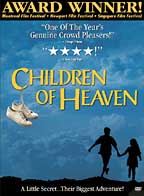 1997, color feature, 88 minutes
1997, color feature, 88 minutesDirected and written by Majid Majidi
Producer, Amir Esfandiari, Mohammad Esfandiari
In Persian with subtitles
All ages
This Iranian film centers on a brother and sister forced to share a pair of sneakers when the boy Ali (played beautifully by Amir Farrokh Hashemian) loses his sister Zahra's newly-repaired shoes. A meditation on Iranian daily life (including scenes at a mosque), scarcity vs. plenty, and family bonds, Children of Heaven is also a suspenseful yarn. Its PG rating, as near as I can figure, has to do with Ali's father yelling "shit!" when his bicycle breaks stop working and he and his son are about to crash. Also, he is verbally harsh with his family, particularly at the beginning, but it quickly becomes clear that he is honest and loving, if overworked. Engaging, stunning to look at, a glimpse at Iranian culture that has a realistic feel. I'm giving this the "girl power" label because Ali's sister Zahra, played by Bahare Seddiqi, washes the dishes, tends the baby, cleans the house, and gets her homework done—one could imagine such a girl growing up to be a world leader.
Thursday, June 26, 2008
Chisholm '72: Unbought and Unbossed
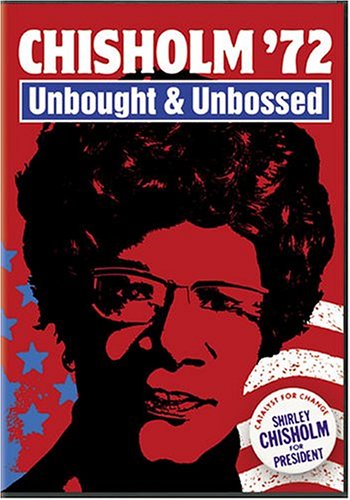
Shola Lynch, 2004
76 minutes, documentary
Best for ages 5+
I was 11 in 1972 when Congresswoman Shirley Chisholm became the first woman and first black person to run as successfully as she did for president of the United States, and my son is 11 now. Watching this documentary with him and my 9-year-old daughter really put this year's campaign in perspective. The footage here demonstrates some of the long road that has led to Barack Obama's candidacy, reveals by contrast the shallowness of the media analysis of race and gender in the current campaign, and offers a refreshing, even bracing introduction to a candidate who was not afraid to speak out and take strong, clear, progressive positions. "I want to be remembered as a woman who dared to be a catalyst for change," said Chisholm. A great introduction to a figure your children should know about (even if they don't understand all of it), a primer in issues that come up in every campaign, and some good context related to the movements for the rights of women and African-Americans.
Friday, May 16, 2008
Cyrano de Bergerac
 Jean-Paul Rappeneau, 1990
Jean-Paul Rappeneau, 1990137 minutes, color feature, subtitles
Ages 8 & up (battle scene at end with explosions and some blood)
With musketeers, witty word play, a confederacy of poets, and a story about who and why we love, the story of Cyrano de Bergerac is great for kids. This production features a spirited, soulful performance by Gerard Depardieu. Another great actor, José Ferrer, made a version in 1950 and there are numerous other versions. My 8-year-old had a little trouble keeping up with the subtitles, but there is plenty of action to keep a non-reading viewer interested, and those who don't follow the subtitles can still listen to the music of the rhyming couplets in French. Girl power alert: Roxanne, love object to two men, has little to do but in Act IV does dress up as a man during a fight with Spanish soldiers and sneak food to the French cadets.
Tuesday, May 13, 2008
Note by Note: The Making of Steinway L1037
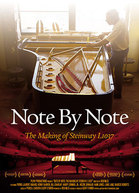 Ben Niles, 2007
Ben Niles, 200781 minutes, color documentary shot on tape
All ages
Anyone old enough to sit through a documentary, and that could be anybody, should be rapt at this account of the process and people behind a Steinway grand piano, from the multinational craftspeople who painstakingly ply their trade in a Queens factory, passing their art down from one generation to the other through hands-on training, to the musicians who appreciate in their own way the personality differences between one piano and another. "It was nice to see the Steinway being made—spray-painted and having its strings straightened," said a 10-year-old viewer.
Tuesday, May 22, 2007
Word Play
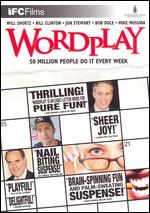 Patrick Creadon, 2006
Patrick Creadon, 2006 94 minutes, color documentary
7 and up, rated PG for mild reasons detailed in the review of this movie at Kids-in-Mind
Using NPR puzzlemaster and New York Times puzzle editor Will Shortz as a focal personality, this documentary is all about crosswords, those who make them and those who complete them—in well under five minutes, every week and at an annual competition held in Connecticut since 1975. Kids should enjoy the story of how Shortz, at a young age, determined to spend his life with puzzles and created his own college major—enigmatology—to prepare himself for his chosen vocation. Others will be amused by the longstanding rule of etiquette that prevents anything remotely scatological from being used in a crossword, a state of affairs that vexes puzzle constructors in need of vowel-rich words like "enema". The DVD comes with lots of bonus features for extra fun that should inspire a run on crossword books at your house.
Wednesday, April 18, 2007
Women. We'll Settle for Half.
 That's the official t-shirt of an organization called See Jane, founded by Geena Davis to correct the remarkable continuing disparity between male and female characters in programming aimed at young people. Incredibly, the entertainment industry needs more studies and data to convince it that girls, and female smurf-like characters and animals and so forth, are still largely missing from the sewage system that is mass media. Such activities keep the Annenberg School in business, I suppose, but sheesh, we all know TV and movies are male-dominated stories told from male perspectives with a pink bow slapped on here and there, and rather frequently a dead mother, to make us shed a tear. What a crushing bore! If it weren't for the exceptions, many of them celebrated right here at Alternative Films for Kids, we'd give up. But the exceptions shine so gloriously that we, like the good people at See Jane, prefer to keep pushing for improvement. Davis spoke about See Jane recently at the National Conference for Media Reform. (After watching Geena, have a look at the amazing keynote by Bill Moyers).
That's the official t-shirt of an organization called See Jane, founded by Geena Davis to correct the remarkable continuing disparity between male and female characters in programming aimed at young people. Incredibly, the entertainment industry needs more studies and data to convince it that girls, and female smurf-like characters and animals and so forth, are still largely missing from the sewage system that is mass media. Such activities keep the Annenberg School in business, I suppose, but sheesh, we all know TV and movies are male-dominated stories told from male perspectives with a pink bow slapped on here and there, and rather frequently a dead mother, to make us shed a tear. What a crushing bore! If it weren't for the exceptions, many of them celebrated right here at Alternative Films for Kids, we'd give up. But the exceptions shine so gloriously that we, like the good people at See Jane, prefer to keep pushing for improvement. Davis spoke about See Jane recently at the National Conference for Media Reform. (After watching Geena, have a look at the amazing keynote by Bill Moyers).More good news for girls: Henry Selick is now in production with an animated screen adaptation of Neil Gaiman's Coraline. This is a story about a girl. That's it! No boy sidekick, no brother, and very few male characters to distract from the strength, determination and loving maturity of the girl who travels to the dark side on a rescue mission and finds her way back again—without a Frodo, a Skywalker, a Buzz Lightyear or a Sully to help her.
Labels:
activism,
animation,
girl power,
hollywood
Tuesday, April 10, 2007
Musik und Zaubereien & Märchen und Fabeln
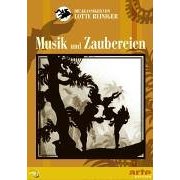 250 minutes, released 2007
250 minutes, released 2007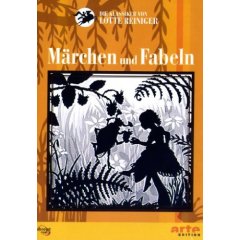 150 minutes, rel. 2006
150 minutes, rel. 2006Lotte Reiniger
Black & white shorts compiled on DVDs
All ages
If you've seen The Adventures of Prince Achmed (scroll down, it's there somewhere), you and your children will no doubt be delighted that more of the work of Lotte Reiniger, the brilliant German animator who lived from 1899 to 1981, is available on DVD. The delicate silhouettes, in black & white, tinted, and in color (though they're best with the more muted backgrounds), enchant in these versions of popular fairy tales such as "The Golden Goose," "Cinderella" (note for younger viewers: the sister slices off her heel and makes a bloody mess!) and "Jack in the Beanstalk." Musik und Zaubereien gives us a Magic Flute with the best bits of Papageno—as he sings, women turn to birds and fly away, eggs hatch to reveal Papageno & Papagena's babies. "Carmen" has a happy ending and a feminist spirit that infuses many of Reiniger's short films. Hours of stunning animation here, mostly suitable for all ages. These may be hard to rent but can be ordered from Amazon.de—I was surprised to find that my U.S. account and password transferred without a hitch.
Monday, April 09, 2007
The Way Things Go
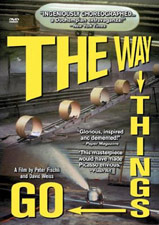 Peter Fischli & David Weiss, 1987
Peter Fischli & David Weiss, 1987color, 30 minutes
All ages
"Everyday objects doing cool things," is how my daughter described this chain of events set off by a spinning garbage bag. Foam, fire, explosions, liquids and wheels, a bit of physics and chemistry, and you have thirty minutes of ooh-ing and ah-ing. Delightfully, this film is ultimately about story, and children will love being the narrator, but they should spend at least one viewing listening. The Honda ad, "Cog," that purloined the concept and ideas from this film inspires awe too, but the original is more fun—longer, messier, and the objects have more personality.
Highly recommended for all ages.
Thursday, March 15, 2007
Alternative Videos of Woodstock CLOSED
Their name was already outdated, as they were replacing tapes with DVDs. So is our other local store, Alice in Videoland. "Alternative DVDs of Woodstock" and "Alice in DVDland" sure don't sound too poetic, but they wouldn't have lasted long anyway.
Members filed into the store at noon to pick over the stock. Hard choices. My son and I wound up with a bag full—a Scooby Doo tape, Cirque de Soleil and an episode of Ghost Writer (scored by a family friend) for him. For me and the rest of the family:
Documentaries: The Wobblies, Sister Helen (I thought it was about Helen Prejean; it's not; I hope it's good), Kilowatt Ours, In the Mirror of Maya Deren, Yours for a Song: The Women of Tin Pan Alley; Cinema Verite: Defining the Moment
Animation: Hiroshima No Pika; The Adventures of Prince Achmed (scroll down for the altfilmskids review)
Features: I Know Where I'm Going, Alexander Nevsky, Last Year at Marienbad
Compilations: America's First Women Filmmakers; Treasures from the American Film Archives
Performance: Great Pas de Deux for the ballet dancer in the family.
I didn't take the best stuff there but what I did get took two hours of standing in line at lunch hour and it was hard to choose.
I ran into four friends there and chatted with strangers. The woman next to me on line and I praised Tilda Swinton's performance in Deep End and discussed other films about motherhood. Another woman held up Black Stallion and said the opening was one of her favorite films, with which I heartily concur. Another woman bought every episode of The L Word. It was like a funeral—nice to be with people but for such a sad occasion, with all our favorite store employees pacing the aisles behind the counter to match empty boxes with tapes and discs. This is one of those stores where the staff is learned, like librarians, not like the vapid crew at Blockbuster, where you go in and ask for Meet Me in St. Louis and the kid has never heard of Vincent Minelli. This is a real loss to the community, and you probably have a similar story in progress in your town.
I wish everyone at Alternative Video a future of luminous endeavors.
Members filed into the store at noon to pick over the stock. Hard choices. My son and I wound up with a bag full—a Scooby Doo tape, Cirque de Soleil and an episode of Ghost Writer (scored by a family friend) for him. For me and the rest of the family:
Documentaries: The Wobblies, Sister Helen (I thought it was about Helen Prejean; it's not; I hope it's good), Kilowatt Ours, In the Mirror of Maya Deren, Yours for a Song: The Women of Tin Pan Alley; Cinema Verite: Defining the Moment
Animation: Hiroshima No Pika; The Adventures of Prince Achmed (scroll down for the altfilmskids review)
Features: I Know Where I'm Going, Alexander Nevsky, Last Year at Marienbad
Compilations: America's First Women Filmmakers; Treasures from the American Film Archives
Performance: Great Pas de Deux for the ballet dancer in the family.
I didn't take the best stuff there but what I did get took two hours of standing in line at lunch hour and it was hard to choose.
I ran into four friends there and chatted with strangers. The woman next to me on line and I praised Tilda Swinton's performance in Deep End and discussed other films about motherhood. Another woman held up Black Stallion and said the opening was one of her favorite films, with which I heartily concur. Another woman bought every episode of The L Word. It was like a funeral—nice to be with people but for such a sad occasion, with all our favorite store employees pacing the aisles behind the counter to match empty boxes with tapes and discs. This is one of those stores where the staff is learned, like librarians, not like the vapid crew at Blockbuster, where you go in and ask for Meet Me in St. Louis and the kid has never heard of Vincent Minelli. This is a real loss to the community, and you probably have a similar story in progress in your town.
I wish everyone at Alternative Video a future of luminous endeavors.
Thursday, February 01, 2007
Masters of Russian Animation, Vol. 1
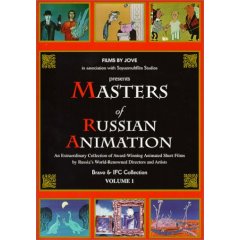 Various directors, 2000
Various directors, 2000Animated, Color, Subtitled, 133 minutes
All ages
Films included: The Story of One Crime (1962), The Man in the Frame (1966), My Green Crocodile (1966), There Lived Kozyavin (1966), Mountain of Dinosaurs (1967), Passion of Spies (1967), Glass Harmonica (1968), Ball of Wool (1968), Singing Teacher (1968), Film Film Film (1968).
A compendium of Russian shorts from the 60s produced in a variety of animation styles. Especially recommended: Vadim Kuchevsky's sweet, lyrical My Green Crocodile, done in stop motion; Nikolai Serebryakov's Ball of Wool about an old woman who knits herself a house from the wool of a magic sheep and is undone by her own greed, also stop-motion; and Anatoly Petrov's humorous Singing Teacher, done in pencil drawings, in which a hippopotamus tries warbling.
Tuesday, December 12, 2006
You Can't Be Neutral on a Moving Train
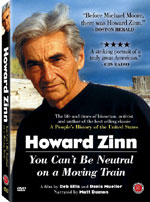 Deb Ellis and Dennis Mueller, 2004
Deb Ellis and Dennis Mueller, 2004color and b+w documentary, 78 minutes
Ages 9? & up
Resident 9-year-old says, "Well, I enjoyed it, but I think most kids would be restless and would rather watch a horrible crappy movie called The Wild instead of this." (Um, we didn't see The Wild.)
It ain't for nothing that you're parked at Alternative Films for Kids, folks!
This profile of professor/activist Howard Zinn, author of The People's History of the United States (which has sold a million copies), covers his adult life, which has spanned many of the key social and peace movements of our time. Ellis and Mueller track Zinn from his labor activism to his experience in the air force to his days as a Civil Rights leader at Spelman College to his peace activism during the Vietman War—and beyond. This is a great way for kids too young to read A People's History to learn some people's history—through the life of an engaged historian who continues to work for social justice.
Definitely not The Wild.
Note: contains some graphic archival footage of American police brutalizing demonstrators, bombs dropping during WWII and Vietnam, and Vietnamese civilians under attack.
Labels:
activism,
American history,
documentary
Whale Rider (in Maori: Te kaieke tohora)
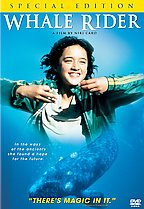 Niki Caro, 2003
Niki Caro, 2003color feature, 101 minutes
Rated PG-13
Could be ok for ages 5 & up but prescreen it and judge for yourself!
I had to wait a few years to show my 7-year-old daughter this amazing tale of a girl who turns life around for everyone in her New Zealand Maori village, because the conflict that drives the story—her grandfather's rejection of her leadership because she is a girl—is so unsettling and sexism is a complex topic. Keisha Castle-Hughes is perfect as Paikea, a girl born into a long line of male chiefs in a society drifting away from its roots. The PG-13 rating seems to come from fly-by uses of d*** and b******, but the real caution is the harshness of grandfather, played beautifully by Rawiri Paratene, who requires a miracle to convince him of the rightness in his family line. This is a story of love among family, community, ancestors and planet that defies gender expectations all around.
Tuesday, November 21, 2006
A Wrinkle in Time
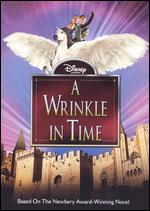 John Kent Harrison, 2003
John Kent Harrison, 2003color feature, 128 minutes
This Canadian adaptation of Madeleine L'Engle's classic would surely not have been as compelling had it been made in the States, where one never finds this much feminism packed into two-hour movies, particularly for children. We have a teenage girl protagonist/hero, three cosmic beings led by Alfre Woodard as Mrs. Whatsit representing Divine Love, a worm-like being with a masculine face representing God-the-Authoritarian-Father, and a very human father too injured to be the one to rescue his young son. Kate Nelligan as Mrs. Which and Alison Elliott as Mrs. Who, a family in which both parents are Ph.D.'s, Aunt Beast (yes! even a Wookie-like monster is female!—this one with magical healing powers) round out this experience of non-stop woman power. Brava! Every kid should see this; my kids have rented it twice; recommended for 7 or 8 and up.
Hollywood please take a lesson from our neighbors to the north.
Monday, October 23, 2006
Beckett on Film
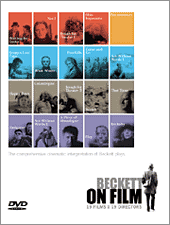 19 plays, four DVDs
19 plays, four DVDsVarious directors, 2002
Produced by Michael Colgan and Alan Moloney
Age 6 and up
A couple of years ago my children created a drama in which they pretended to leave home with picnic lunches, traveled in a circle on a sofa for a while, and then began to sink in quicksand while trying to eat. "This is just like Beckett," I thought to myself. In the years since, they've become fans of Buster Keaton and the leap to Beckett is a natural one. Beckett on Film offers the perfect opportunity to explore his plays with your youngster, with directors like David Mamet and Atom Egoyan and actors including John Gielgud, Jeremy Irons, Kristin Scott-Thomas, Juliet Stevenson, & John Hurt. As we view the discs, I'll share our recommendations. They can be rented one at a time, at least from Netflix.
Disc 2: Includes "Krapp's Last Tape," "What Where," "Footfalls," "Come and Go" and "Act Without Words I." I recommend trying anything on this disc. My daughter watched all of "Krapp's Last Tape," while my son got bored during the second half—but they both loved the slapstick, which included John Hurt slipping on a banana peel. They both liked the silent "Act Without Words I." My son watched "Footfalls" twice, which I found somewhat surprising, but you never know, which is why anything appropriate and worth viewing, is worth trying with kids. Disc 4: "Act Without Words II," "Rockaby" and "Play" are recommended. "Play" has a few bad words but the characters, who are sitting in urns and brilliantly played by Juliet Stephenson, Alan Rickman and Kristen Scott-Thomas, speak very fast. The other two discs are less compelling to kids, I'd say.
Wednesday, October 11, 2006
Life: A Journey Through Time
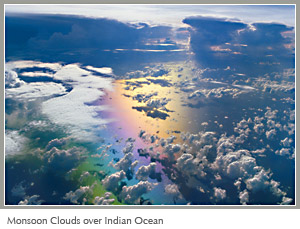 Frans Lanting
Frans Lanting Viewable online
All ages
"The Life Project is a lyrical interpretation of life on Earth from its earliest beginnings to its present diversity." Start with the slideshow on the website, then explore the timeline. This is all part of a multivenue spectacle that includes a book, orchestral performance (music by Philip Glass), and exhibition (scheduled to tour the world), in which images by Frans Lanting, a photographer for National Geographic, are placed in the service of telling the story of life on our planet. Read along with the slideshow or not...the pictures tell the story either way. Stunning.
Monday, October 09, 2006
A Touch of Greatness
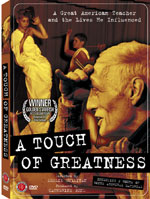 Leslie Sullivan & Catherine Gund, 2004
Leslie Sullivan & Catherine Gund, 200454 minutes + bonus material, color/b+w documentary
All ages
This portrait of progressive educator Albert Cullum offers inspiration to anyone who has ever been wearied by the education system. As a teacher in a conventional public school in 60s Rye, New York, Cullum introduced drama, spectacle and fun to his classrooms. For geography, the class went outside and hopped on one foot across a United States chalked onto blacktop, and "swam" a Mississippi River made of a long role of paper. Cullum directed student productions of Shakespeare in which his only notes, he claimed, were "I don't believe you." The results were stunning. Blends interviews and archival television broadcasts with film footage of productions of Shakespeare, Antigone and Joan of Arc shot by Robert Downey, Sr. My son said, "If all teachers were like that, I'd want to go to school." (If you're sending your child to a stultifying place for indoctrination, beware...they may not want to go back after watching this.)
Wednesday, October 04, 2006
An Inconvenient Truth
 Davis Guggenheim, 2006
Davis Guggenheim, 2006100 min, color documentary
Ages 8 and up
"If this is happening, why don't they do something about it?" was my daughter's response after watching An Inconvenient Truth at the Hyde Park Drive-In, a special screening organized by the environmentalist organization, Scenic Hudson. I had worried that the movie would upset her, but I think she related to it as more of a science lesson, and Al does leave things on a rather bright note, stressing the potential for change and the generous ability of the earth to bounce back after extreme injury. My son (9), saw it with me when it opened, and now has seen it twice, and I think it's a good one for the right young viewers. They get a lot of earth science, particularly graph-reading experience, and Al's story of how he became a global warming activist, interspersed with his lecture on the state of the planet, is moving and inspiring. No time like the present to get kids thinking about the defining issue of their generation.
Who Killed the Electric Car?
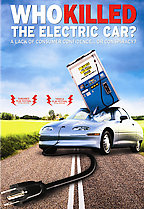 Chris Paine, 2006
Chris Paine, 200692 minutes, color documentary
Ages 8 and up
I took my kids to the theater to see this, and they had no trouble sitting through it, though the 9-year-old seemed to have an easier time following the story of the rise and fall of the electric car—and the various parties complicit in its demise—than my 7-year-old. This is one of the best-paced, most absorbing documentaries of its type I've seen, presenting a wealth of material in an intelligible way. A great discussion-starter about Big Oil, Big Autos, transportation alternatives, how public policy is created, consumer activism, and so on. The shadow issue lurking in the background of course, is whether automobiles are viable at all, but at least this is a place to start.
Who Killed the Electric Car? has a nice website with a teacher's guide, if you're into that sort of thing (In my experience kids come up with more interesting discussion questions than grown-ups.)
Rated PG for "brief mild language," but I can't even remember what it was. I think it will fly past most ears but make sure you pre-screen if you're concerned.
Labels:
activism,
documentary,
eco,
science,
technology
Monday, October 02, 2006
A Note About Subtitles
Introduce subtitled movies early in your child's movie-viewing life (which should begin as late as possible) and don't make a big deal about it, is my unasked-for advice.
Most of the subtitled films I mention here are primarily visual and children can understand the story without reading. Some kids will be willing to read subtitles (if they are reading in general), some will just watch the images (fine), others will ask you to read (my husband and I take turns).
As they say, it's all good.
Except for the "English" option on DVDs. In my experience that is intolerable, but my 7-year-old did watch much of The Bicycle Thief with it turned on. Oh well, at least she saw the film.
Most of the subtitled films I mention here are primarily visual and children can understand the story without reading. Some kids will be willing to read subtitles (if they are reading in general), some will just watch the images (fine), others will ask you to read (my husband and I take turns).
As they say, it's all good.
Except for the "English" option on DVDs. In my experience that is intolerable, but my 7-year-old did watch much of The Bicycle Thief with it turned on. Oh well, at least she saw the film.
The Bicycle Thief
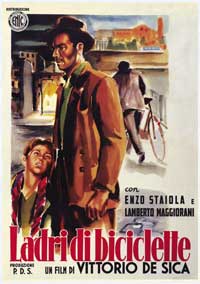
Vittorio de Sica, 1948
93 minutes, black & white
Italian with English subtitles
Ages 6 or so and up
My 9-year-old was rapt watching the elegant, simple story of a man on a mission to find a stolen bike without which he can't work or feed his family. The life of the young son, so different from ours, was a good starting point for a discussion of postwar life, poverty, urban hardship...depressing, but it worked for us, and it's an accessible cinematic classic.
Good go-with: Marcovaldo, short stories by Italo Calvino, set during the same period and later, can definitely be enjoyed by children.
Solidarity Not Charity
 Common Ground Collective
Common Ground CollectivePosted to their website
Viewable online
All ages, but 5+ will get the most out of it
This organization has been working with New Orleans communities to gut homes, offer healthcare, keep people fed, fight evictions...you name it, all with a view to sustainable, nontoxic operating strategies. If you want your children inspired by the possibility of social change even in the midst of unthinkable disaster and governmental abandonment, here's a short, free stop you can make on your information highway cruise. Wish I'd known to post this a long time ago, but it's never too late to watch it with your kids and donate, send supplies, or better yet...take a working vacation. These folks have skills we can all use.
Labels:
activism,
African-American history,
American history,
eco,
poverty,
view online
Friday, September 22, 2006
Heart of Tibet: An Intimate Portrait of the 14th Dalai Lama
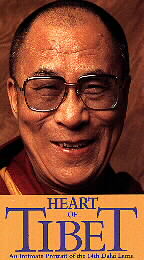 David Cherniack, 1991
David Cherniack, 199160 minutes, color documentary
5 up
This portrait of the 14th Dalai Lama was created during a visit to California and includes interviews with American scholars of Buddhism such as Robert Thurman, plus footage of the Dalai Lama being interviewed by journalists, meditating, and making the rounds as he is greeted by supporters in the U.S. I especially liked these scenes, which focus on close-ups of people as they look into his eyes—one thing everyone seems to agree on about the Dalai Lama is that meeting him is an experience of pure joy. Parents of very young children be advised: provides background on the Chinese invasion of Tibet that includes archival footage of soldiers brutalizing Tibetans. An introduction to Buddhism that kids 5 and older should understand, as the Dalai Lama, the "simple monk," speaks plainly on fundamental subjects: love, compassion and service to others.
Wednesday, September 13, 2006
Primal Mind

Don Lenzer, 1996
With Jamake Highwater
58 minutes, color documentary
Ages 5 and up
Author Jamake Highwater talks about his own experiences growing up as an Indian in a foreign, dominant culture and the peceptual divide between primal and European cultures. He moves fluidly among topics—art, architecture, dance, painting. This is aimed at viewers of at least young adult age, but there is so much of interest to look at, and Highwater makes his points so clearly, that any child could benefit from one or more viewings.
Making Grace
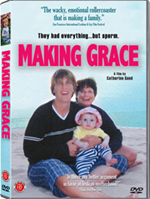
Catherine Gund
87 minutes, color documentary
All ages
A warm document of the journey of a couple, Anne Krsl and Leslie Sullivan, toward motherhood, following them through several visits to a doctor for insemination and culminating in the birth of their daughter, Grace. I watched this with my seven-year-old daughter and during and after, we talked about the various ways families are created. She loved it. When I asked her what she loved about it, she said "Everything." When I asked her what images stayed with her from the movie, she said "Grace." I think she got the idea. It's about love, perseverance and naturally, grace. Incredibly moving to see how a child's birth can heal a family and create community.
Friday, November 25, 2005
Sita Sings the Blues/The Sitayana
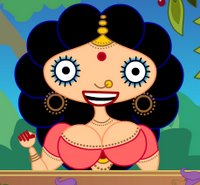 Artist Nina Paley
Artist Nina PaleySita Sings the Blues/The Sitayana; Viewable online
The Ramayana and the blues of the 20s (via vocalist Annette Hanshaw) get an exhilarating animation treatment from Nina Paley in this movie that's an accessible retelling of The Ramayana from Sita's perspective, and a fiery cross-cultural mash-up. Paley has been slowly building this work for years. When I first posted about it, Sita Sings the Blues was in progress and Paley was posting it to her website in chapter-sized chunks—now it's finished and collecting awards at festivals.
Here's a New York Times piece about it and how Paley developed the idea—a great story for people of any age about how creativity can be fueled by personal circumstance.
Despite Paley's difficulty in securing copyrights for some of the music in her animation, beginning February 26, 2009, Sita Sings the Blues will be viewable online through Channel 13, which is allowed to show it as a public broadcaster. This should be an active link to that.
For more of artist Nina Paley's work, including her graphic contributions to the Christmas Resistance Movement, visit
http://www.ninapaley.com/
Wednesday, September 21, 2005
Touch the Sound
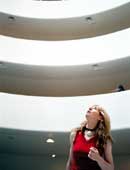 Thomas Riedelsheimer, 2005
Thomas Riedelsheimer, 200599 minutes, color documentary
All ages
Evelyn Glennie, a deaf percussionist, plays a variety of instruments with several collaborators in this portrait of her that focuses on the question of what is sound, exactly, and how do we hear? The body as a resonator, synaesthesia, the sheer joy of having a huge space to bang a gong in—like Rivers and Tides (see below), Riedelsheimer's portrait of this sound artist is an exploration of how humans play in the world, this time focused on the vibrations around us. Interview footage with Glennie is alternated with various performance pieces, including several lovely marimba duets with guitarist/musician Fred Frith. My eight year-old said, "I thought it was about different instruments—how you don't have to use an instrument for the thing it was made to do." In theaters as of this writing; waiting for DVD might be a good idea, as watching it in pieces will help restless viewers. Riedelsheimer does not rush his material.
Rivers and Tides
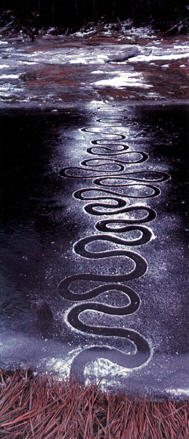 Thomas Riedelsheimer, 2001
Thomas Riedelsheimer, 200190 minutes, color documentary
All ages
This is Riedelsheimer's beautiful portrait of sculptor Andy Goldsworthy, who works outside with elements of nature as his media: leaves connected by their stems carefully graded by color and set loose on a river, stones piled in to a beehive shape, scraped ice.
The movement of the sun and changes in the weather figure into his work as well, and children will recognize in Goldsworthy's studious, ambitious play, aspects of their own earthworks (if not, they need to spend more time outside).
The langorous, meditative pace of this film may be hard for children used to sensory overload, but the sheer technical skill Goldsworthy brings to his work should hold anyone's attention, and if you rent it you can watch it in pieces.
Wednesday, August 17, 2005
The Point
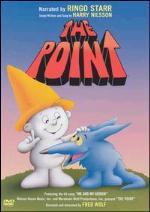 1971, Dir. Fred Wolf
1971, Dir. Fred Wolf74 min., color animation
Music by Harry Nilsson
Ages 5 and up
My generation saw it broadcast on TV; young ones now can rent it, and the message of accepting difference stays relevant. Most important, the music by Harry Nilsson will always be groovy. With voice performances by Ringo Starr as the father and Mike Lookinland (Bobby from The Brady Bunch) as the sweet wayfarer Oblio.
Tuesday, August 16, 2005
Love Is So Sweet

2004, Henry Lowengard and Nancy Graham—aka your host, red eft
Color digital animation
All ages
Here's one you can view online, in high- and low-bandwidth versions. My husband and I made it as an email Valentine; our daughter sings on the vocal track. Young children like to dance along with the animated characters with heart-shaped torsos; none are wearing any clothing, so consider this a naturalist cartoon.
Here's the link:
Love Is So Sweet
Saturday, August 13, 2005
The Dancer
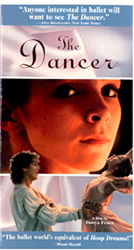 1994, Donya Feuer
1994, Donya Feuer96 min., color documentary
Swedish w/English Subtitles
All ages
The Dancer follows Katja Bjorner, a teenage ballet dancer through rehearsals at at the Royal Swedish Ballet School, competitions and stage performance. Directed by a dancer, this film allows for lengthy, generous close-ups on the feet and hands, but it is the face, sweating, composed, emitting short breaths, that speak most eloquently of the dancer's discipline. There are no bloody unwrapped feet here, no anorexia or moments dwelling on missed opportunities—this is a vision of ballet as hard work and a big dream come true.
Fleshing out the studio sequences is a trip to the ballet shoe factory, where men stand all day at lasts making custom-fit shoes for dancers. We get to see them apply layers of fabric and wheat paste, shape the block, nail and ply the shoe—an art and discipline in itself.
Saturday, August 06, 2005
Charlie and the Chocolate Factory: Not Independent, I just feel like writing about it and it's my blog after all
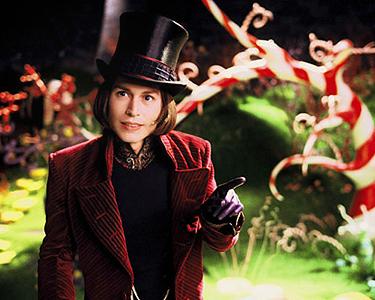
Tim Burton doesn’t need me to send people to the box office, but I’ve loved his recent work too much not to have a say about his latest alter-ego, and there’s no reason to leave things to film critics who work way too hard to be hip, ironic and smart all at once, like Anthony Lane ironizing in The New Yorker:
“The new Tim Burton movie stars Johnny Depp as an ageless weirdo, whose magical skills are matched only by his hangups about where he came from and how he is supposed to make friends with regular people. The film is called ‘Edward Scissorhands.’”
Sorry to pick on Anthony Lane but it’s too late to be reviewing CCF; maybe not too late to review a review of it.
Lane is right in seeing shades of Scissorhands in Willy Wonka, the latest of Tim Burton’s creative-genius-cum-social-misfit characters. Jack Skellington, Ed Wood, Batman and Beetlejuice are all here, but most of all Edward Scissorhands, who is referenced in everything from the production design of Charlie’s house, with its caving-in roof, to the grid-like orderliness of the town, to the scissors in Wonka’s hand when he cuts the ribbon to his factory, to the association of snow with love and creativity, to the tinkling incidental stylings of Danny Elfman.
With his continuing stories of outsider-artists, Burton has created something contradictory and, to use one of Wonka’s favorite words, “weird”—a series of personal blockbuster films. CCF, which is as surely about cinema as it is about candy, wrestles with this contradiction on the thematic level: how can someone so far-out be such a screaming financial success? Wonka, like Burton, is a wild, sometimes brooding talent making it in a bottom-line world, and while it isn’t cool anymore to talk about capitalism, it’s hard to keep from mentioning CCF’s many inconsistent messages about assembly-line production, wage slavery and machines/squirrels/Oompa Loompas vs. people. Burton and screenwriter John August are content at film’s end to leave most of Charlie’s town unemployed, supplanted by automation and “imported” workers from an undeveloped country willing to work for chocolate. (A chocolate Walmart Empire? Yes, you should be disturbed!)
But CCF is mostly about Wonka’s relationship to Burton’s other misfits and to Burton himself. Here, Edward Scissorhands has found success and fame, but something is still missing, that little thing called love, and whether, and how, it can co-exist with artistic flow. Finally, Edward has found his way out of isolation, if not out of his castle.
When Charlie leaves his crooked house and his endearing family (an only child with—count them!—six supportive parents to Wonka’s bitter single father) and enters the factory with his ticket-holding peers, the movie faithfully follows the book’s trail of cautionary disappearances, one misbehaving child after the next. The other kids are archetypal variations, children gone bad at the hands of distant parents. They all have some kind of exaggerated attachment disorder, and it will be up to Charlie and Grandpa Joe to show the worst case, Willie Wonka himself, out of his suffering. As in the book, children will be sucked into tubes, turned into blueberries and sent down garbage chutes, but the source of evil, and this is really elaborated in the movie, is an absence of appropriately nurturing parents: instead, they are rigid and distant, permissive and distant, controlling and distant. The failure of those who don’t “win” the Factory gambit is a failure of intimacy. (It's a failure of imagination too, of course: what does one do with a child all day? Park it in front of the TV, feed it, sign it up for competitive sports, give it presents.) The consequences suffered by those who don’t pay attention to Wonka, as Dahl wrote it and as underscored in this version, are not so much penalties exacted by him as the natural consequences of choices those families have made from the beginning.
Wonka knows this: we see him eye his charges shrewdly throughout the tour (one nice transition cuts from Wonka’s face to all the children and their guardians minus Wonka, seen from behind in the pink dragon boat; another shot lingers on Veruca Salt’s father, a nut factory owner, and Willy as they lock gazes). He pretends not to know their names and histories, although he obviously does his research and the film’s opening shows us how dysfunctionality takes only a quick newsclip to spot (of the ticket-holders, only Charlie is spared the pre-tour media blitz). Shying from Violet Beauregarde’s mother to sit by Charlie and Grandpa Joe (who unlike the other parents is roughly a contemporary of Wonka’s own father), Wonka offers Charlie a ladleful of chocolate, because he looks so hungry.
As for the other children, well, where they’re headed was a foregone conclusion when they opened their mouths on TV and told the world how they won, whether it mattered to them, and why. “There is no doubt that [Wonka] despises them,” writes Lane, “and that raises questions as to why he has lured them, with promises of candy, into his edible home.” In order to find just one like Charlie, is why. In order to befriend someone who knows that candy doesn’t have to have a point, but that there is a point to having a family.
It is Charlie who heals Willie’s rift with his father and gives him another try at having a family. And though Willie credits an Oompa Loompa with inspiring the psychoanalytic revelation that leads to his union with the Buckets (“I need a hair/heir!”), it’s Charlie who’s the real therapist, asking Willy leading questions throughout the tour: do you remember being a child, do you remember your first candy—finally giving his blessing to Willy’s genius (“It doesn’t have to have a point. That’s why it’s candy.”) What distinguishes Charlie from the other children is that he's treated like a person instead of a child; he's treated as a responsible member of his household. Burton himself has said Wonka hates children, but he flees from people of all ages; he's misanthropic. He likes Charlie, and Charlie is a child. Age is not the issue.
Like J.M. Barrie's gossipy friends in Finding Neverland, Lane has insinuations to make about Willy Wonka. (The Michael Jackson overtones imputed to Depp by so many viewers seem to me to lead nowhere, and distract from the story). True, Depp’s Wonka may be outlandish, androgynous, even foppish, but that doesn’t make him a sexual creep. One of the ways Burton won my trust was in the casting, through the relationship Johnny Depp and Freddie Highmore carry over from Finding Neverland. Another way he won it was by first making Big Fish, another fable about father-son reconciliation, in which the threatening atmosphere ultimately has to do with unconsious fears and the demands of the tall tale. In Big Fish, Burton is not about creeping us out; the eeriness heightens the everyday, common love that turns the wheels of the story. You can’t move the audience without a little friction, some gray areas, some uncertainties. But does Wonka try to lure a child alone with him into the Whipped Cream room? No.
Not that Depp’s Wonka should appeal to everyone, he's twisted and subversive in the Roald Dahl tradition, but I don’t think Depp and Burton have a nasty or sadistic intent. I didn’t react that way, and neither did my highly-sensitive children. Lane, reminded by Depp’s performance of Oscar Wilde, Michael Jackson and Tootsie (I guess because Lane thinks Depp’s fake teeth make him enunciate like Dustin Hoffman in that film), asks, “Where does moral tutelage end and sadistic farce begin?” The answer is that, as usual in his work, Burton gives us more, a fable wrapped in a fairy tale. There are moral lessons but there is magic, darkness, beauty and transcendence, too.
Hollywood is woefully short of new fabulists; children’s animation is often stuck in the land of irony and allusion, and there isn’t much in the way of live-action fare for anyone under ten, so many of us are grateful for this story in which the two little boys—Charlie and Young Willy—possess gifts young people (girls half the time, but don’t look to Burton for that) bring into the world and then, too often, have crushed out of them: the power to heal and the power to create. People keep asking “Why the Wonka backstory?,” but I like how the boys communicate across the years, both of them heroic and resistant to dominant culture in their own ways, and in ways that are not stereotypically masculine.
As for their foils: Veruca Salt, Augustus Gloop, Mike Teavee and Violet Beauregarde are recast in this version of CCF as more than deadly sins, they are authoritarian party-poopers, parental stand-ins who heckle Willie Wonka mercilessly about the practicality of his inventions. If we're not sorry to see them go, maybe it's because we have no trouble signing on to Wonka's tests. Will they listen to his ground rules? That's one test. The other is uniquely an addition of the film's, and characterisically Burtonesque: will they tolerate Wonka's creative excesses, his impractical, even useless dreams? “That makes no sense,” Veruca says of a Wonka creation, and Mike Teavee pronounces everything at the factory “totally pointless,” dissolving, in image and voice, into Wonka’s rejecting father, who echoes from the past, “Candy is a waste of time.”
Candy is a waste of time. So is filmmaking, unless you can make “buckets” of money at it. One of the joys and vicissitudes of the creator, whether candymaker or filmmaker, is that the artist’s imagination gets a vigorous workout while the consumers—the gluttonous Augustus Gloop, the full-time spectator Mike Teavee—consume. One person’s exuberant play is someone else’s addiction. Although the Wonka-as-director theme plays out during the entire factory tour, it is in the TV room scene that Burton makes the association to visual confections and their passive spectators (us) most explicit. Can we all be Wonkas or must most of us just sit and watch all the fun? In Burton’s other films, there is room for only one Misunderstood Creator. This time he moves over and makes room for another, a boy whose imaginative fancies are fueled by happiness instead of torment. As he proved with the big-hearted, forgiving Big Fish, Burton has matured.
Wonka’s response to the stifling little girls and boys he mistakes for his p-p-par-unmentionables is a series of childish outbursts. “Mumbler!” he shouts at Mike Teavee. “Seriously, I cannot understand a single word you’re saying.” They don’t speak the same language, and it’s no wonder that Wonka, the boy who felt so misunderstood he ran away from home, grew up to conclude, “A family is not conducive to a creative atmosphere.” Or is it? That’s the transformation we see with this Willy Wonka, and that’s what makes it a family film.
Wednesday, July 27, 2005
March of the Penguins
 2005, Dir. Luc Jacquet
2005, Dir. Luc Jacquet80 minutes, color documentary
The story of how the Emperor Penguin treks seventy or more miles across the ice to mate and create a rookery with fellow penguins is as compelling as any animal narrative could be. Penguins offer an example of animal fathers parenting equally, and watching the care with which both parents tend the egg and chick is profoundly moving. The best thing about this documentary is the photography; the camera that lingers over the birds in extreme close-up. It's a privilege to be able to observe them, in movement and in stillness, in a climate no blooded being should be able to call home.
There's a G rating, but parents of young children should know that some eggs and chicks don't make it—we watch an egg freeze on the ice, a father looking on helplessly; in another scene several fathers pass an egg on the ice and stop to eye it; there is a frozen chick. I left early with my six-year-old because that image made her so sad.
I'm going to write in more detail about this over on my other blog Oswegatchie, but I would very much prefer a different philosophy of scoring and narration in documentaries such as this one. There is way too much mainstream pressure on nature documentarians to 1) compare animals to humans; 2) score their "antics" to amuse us; 3) have a narrator blab at us in a not-particularly-enriching way.
Sunday, July 17, 2005
The Dark Crystal
 1982, Dir. Jim Henson, Frank Oz
1982, Dir. Jim Henson, Frank Ozcolor, 93 minutes
Ages 6 or so and up
Henson and Oz pushed their muppetry to its mythic potential in this story of a world split into good and evil on the eve of its reintegration. The Dark Crystal gets extra credit points for two strong female characters, one an eccentric astronomer who can remove an eyeball and pop it back in again and the other a gifted animal communicator who (unlike her male counterpart) can unfold her wings and soar; also note the gender-neutral skeksis, creatures reminiscent of vultures. Inventive sets and lyrical interludes make this well worth watching even for any age. The skeksis can be frightening and there are some scenes my children find so suspenseful that they turn their heads away, but in general, they love this one. Bonus features include extensive interviews with the artists about the making of the sets and creatures. A must see for any child into the plastic arts, puppetry or fantasy stories.
Saturday, June 25, 2005
Gumby Show at AMMI on until January 2006
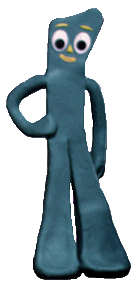
My son and I journeyed south to Astoria yesterday to spend the day with Gumby at the American Museum of the Moving Image. I worked there for about five minutes in the mid-80s, ok a bit longer, but it was during the period of rapid change when I hopped jobs and apartments frequently, that is to say, I was a young, unattached, restless New Yorker.
I still have a friend working at AMMI and it was great fun to visit him and see some of the inner workings of the museum. But the Gumby exhibit was the main attraction. My son, a committed filmmaker, liked the Gumby claymation demo well enough, but adored the 2D animation station, where the two of us sat side by side for hours making 100-frame animations with the provided cut-outs, then watching them. We saw a bunch of Gumby episodes, but my favorite piece from the Art Clokey oeuvre was a short called "Mandala" from 1964, an Eastern-influenced eruption of plasticity that will make you wish for a studio full of clay and an animation stand. That's what Art had in the 1100-sq. ft. basement where he shot Mandala, and his whole family worked on it. Gumby was something of a family effort as well—many of the plot lines came from stories Art made up to read to his children at night. (Even the shape of Gumby's head was family-inspired, but I won't give that one away if you don't already know; go see the show and find out the source of the adorable bump). We may safely add the Clokey family to the collection of creative spirit guides that inspire our playwork around this house.
Anyway, if you can get to museum, look for "Mandala" and "Gumbasia," Clokey's less commercial works, as well as lots of Gumby episodes, going back to the 50s.
When we finally tore ourselves away from Clokey and Pokey there was plenty else to wonder at, from a moving sculpture by Gregory Barsamian that takes advantage of persistence of vision to the special effects section, where my son took to a documentary about the mixing of archival and original footage in Forrest Gump. At the gift shop, he picked out a director's slate, which he has already started putting to productive use. For my husband, who bears a striking resemblance to the little green fellow, especially when he's smiling, we got a Gumby t-shirt. While animating we had missed the program of silent shorts in King Tut's Movie Palace, but given the choice between spectating and creating, what could we do? The day flew by; we hated to leave, but time was edging toward the last bus departure from Port Authority.
And we hadn't even had time to contemplate seeing the Comix Ex Machina show at the nearby Flux Factory!
Thursday, June 23, 2005
Beatrix Potter: Artist, Storyteller & Countrywoman
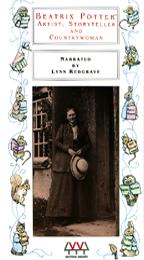
1993, Produced and directed by Cari Best, Paul Gagne and Judy Taylor
55 min., documentary
All ages
This documentary about the life of Beatrix Potter, the brilliant writer/artist behind Peter Rabbit, Mrs. Tittlemouse, Squirrel Nutkin and a dozen other memorable animal characters, gives a great sense of how she became such a fine observer of animals, the role solitude played in her creative development, and the means by which her work was introduced to a wide audience that continues to grow. Includes archival photographs and drawings. Late in life Potter bought land in the Lake District of England and became a conservationist, leaving 4,000 acres to the National Trust when she died. A must-see and a great accompaniment to the Royal Ballet's Tales of Beatrix Potter.
The Tales of Beatrix Potter
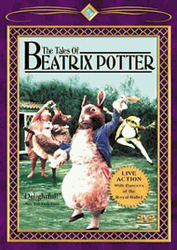 1971. Reginald Mills
1971. Reginald Mills90 minutes
All ages
The pull quote on the DVD cover says "delightful" and there really is no better word for this series of dances by members of England's Royal Ballet, featuring Beatrix Potter's animal characters, from Miss Tiggywinkle to Jeremy Fisher. The sets, costumes and masks and choreography awe and enchant; the dancing is fine and the slow pace and quiet moments are welcome (especially in contrast to what we watched afterwards, Looney Toons Back in Action—an unremitting assault on the senses; sorry to be square but within a few years I think we'll be diagnosing a lot of five-year-olds with tinnitus).
Monday, May 30, 2005
Ah! The Hopeful Pageantry of Bread & Puppet
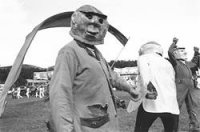
2002, Dir. Dee Dee Halleck & Tamar Schumann
84 minutes, color documentary
All ages
Plunge into the casual, creative community of the Bread & Puppet Theater in northeast Vermont, where people pilgrimage to take part in communal living and the creation of spectacles that advocate peace and decry greed. Children will enjoy seeing how the puppets are made and how people live at the Bread & Puppet farm; learn an important piece of our cultural history; and get an introduction to the work of Dee Dee Halleck, tireless advocate for democratic media. Possibly all ages; you be the judge.
Labels:
activism,
all ages,
American history,
documentary,
puppets
Cane Toads: An Unnatural History
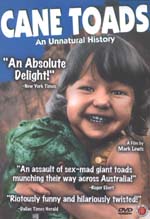 1988, Dir. Mark Lewis
1988, Dir. Mark Lewis48 minutes, color documentary
First Run Features
Who are the cane toads? Marvelously monstrous mega-toads imported to Australia from Hawaii in 1935 in an attempt to eradicate a beetle. The plan backfired bigtime, and this film tells why and shows how Australians, some of them anyway, took the poisonous, plaguey cane toads to heart. I spoke with a 10-year-old who really enjoyed the film, when I showed it to my children at ages 4 and 6 they were a little young; there are gruesome moments and mating habits are covered .
Radical Harmonies
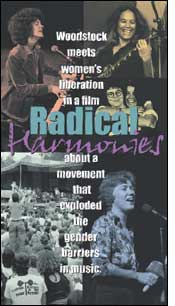 2002, Dir. Dee Mosbacher
2002, Dir. Dee Mosbacher90 minutes, color documentary
The story of the Women's Music Cultural Movement includes interviews and performances of some of the great feminists who revolutionized the music industry with women's festivals, women-owned music labels and women sound engineers. Here is a positive tale of how women seized the means of production at a time and in a field dominated by men. This is also a chronicle of rising lesbian awareness and what it meant to women to attend women's music festivals during the years when they were just getting started. Check out the production company, WomanVision.
One complaint: the performances are interrupted; wish we got to hear full songs interspersed with the interviews.
Ages 5 and up, but as always, pre-screen to verify your comfort level with the material.
I'll Sing for You (Je Chanterai Pour Toi)
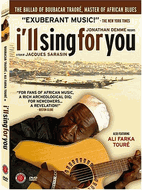
2004, Dir. Jacques Sarasin
77 minutes, color documentary
In French with English subtitles
A portrait of Boubacar Traoré, known as KarKar in his native Mali, where he was wildly poplular in the sixties, known as the voice of independence for his nation. Interviews shed light on his life, but unless your child is a facile reader of subtitles, the focus is the man who sings the story of his life and his country, accompanying himself on guitar (the child who sits improvising songs during his or her spare time will relate easily to KarKar). The music, architecture, faces and daily life of Mali give breath and breadth to this melancholy film. Check out this detailed review for more information.
The death of KarKar's wife, which occupies many of his songs, is discussed, guns go off briefly during a celebration, the word "sh*t" appears in subtitles. Recommended for ages 6 and up.
Saturday, May 28, 2005
We Pause for a Moment to Rail at Hollywood
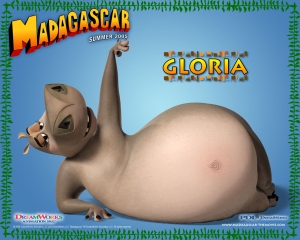
"Which was your favorite character?" My daughter asked me of the film Madagascar, which we saw today. Huh. A favorite. Well, there was basically one female character, a hippopatamus whose job as a character was to support the friendship of the male leads, a lion and a zebra. The zebra's conflict was that he needed some adventure and the lion's conflict was that he was hungry. At the risk of sounding like a humorless feminist, which I often am, I'm just a wee bit bored-to-death with male leads, their male sidekicks, and the females who get a corner of the screen to use staring at the dudes.
My son had been counting down the days until the opening of Madagascar. We had arranged to see it with a friend my children, his mother and his three-year-old brother. Much excitement leading up to it.
My spirits sank as I noticed, while checking showtimes and arranging to meet our friends, the PG rating "for crude humor." "Uh oh," I said into the phone to the other mother without thinking. "Here come the fart jokes. Or worse, if the script is really bad." When I hung up I turned to my son, who had tears in his eyes.
"I'm not going," he said with a choked voice. He really hates "juvenile humor," the provenance of adults with creative limitations who somehow managed, when history named this branch of comedy, to get juveniles blamed for things vulgar. For an hour he argued for staying home. "I won't like it."
"Look," I said. "There are websites for parents where they detail all the things about a movie that might be a problem for parents or kids. I can go read one of their reviews."
"I don't want to know what the problems are."
"That's ok, I'll read and report back to you without the details."
So I read the review on Kids-in-Mind, a site with a numbered rating system for sex and nudity, violence and gore, and profanity that intends to "enable concerned adults to determine whether a film is appropriate for them and their children according to their own criteria and values."
From their review it sounded like Madagascar would have the usual male-dominated cast, with one female in a principal role, the cliché mild-elder-woman-who-beats-up-a-ferocious animal...and we wouldn't be getting away without a fart joke or two. The only value of mine it seemed to support was that the giraffe gets an acupuncture treatment. All right!
And there would be some "name-calling," Kids-in-Mind noted, including "pansies."
The "profanity glossary" on the site says "Words or expressions that are used to denigrate and insult one's racial or ethnic background, gender or sexual orientation: Examples include the N-word, various anti-Semitic terms, and anti-homosexual terms like fa**ot."
In my book, "pansies" is anti-homosexual, so I wrote and told them so (nonsensically, it's also pejorative for "nonviolent").
To my surprise Kids-In-Mind wrote right back, said 'right you are,' and changed their designation of pansies to "derogatory." Which is why I'm plugging their site, which has been helpful to me on other occasions with the Highly Sensitive Viewers at my house. (Who until today, by the way, had never said "that sucks." Thank you so very much, whoever thinks a kid's movie can't do well without a PG rating.)
Hollywood should have purged itself of the anti-gay thing long ago, so why does it persist? And, aside from: 1) the occasionally-enlightened Pixar, which throws girls crumbs like Dory (Finding Nemo) and Jessie (Toy Story 2) and 2) the women's liberaton allegory Chicken Run, which in any case had to cross the Atlantic to be screened in the land where women's suffrage was first won (1869, in Wyoming Territory), why are female cartoon personalities nearly always one-dimensional, often ruled by sex jokes or shunted to the side?
If a female buddy movie starred a zebra and a lion, would they have to drive themselves off a cliff at the end so audiences wouldn't be too threatened by the awesome power of female buddyship? Please!
Subscribe to:
Posts (Atom)

